
views
X
Research source
Because of this fear, taming a feral cat can be difficult.[2]
X
Research source
If you have your heart set on taming a feral cat, doing so will require an abundance of time and patience.
Bringing a Feral Cat into Your Home

Prepare a room for the feral cat. The feral cat should remain in an enclosed area until she becomes more comfortable with you and her new environment. Prepare a small and quiet room, such as a bathroom, that is away from people and other pets. Place a litterbox, a food bowl, a water bowl, and some toys in the room. Make sure the room’s windows and doors are closed to prevent her from escaping. Also, check the room for any holes or cracks where she could manage to get through. If there are shelves in the room, remove anything that she could knock over. Create hiding places in the room (e.g., upside-down cardboard boxes with holes cut out). For at least the first few days, use organic potting soil as litter—the feral cat will be much familiar with this than regular kitty litter. Light the room with a nightlight, rather than turning on the overhead light. The darkness will help the feral cat feel more secure in her new environment. To get her accustomed to human scents, place some old pieces of clothing (e.g., socks, sweatshirts) in the room. The feral cat will need at least a few hours to allow her to settle in.
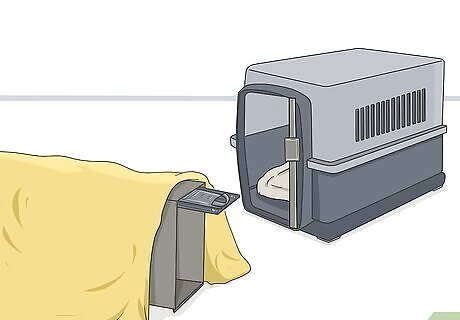
Place a pet carrier in the room with the trap. You will need to take the feral cat to the veterinarian to receive some much-needed veterinary care (e.g., vaccinations, dewormings, FeLV and FIV testing). It will probably be easier to transport the feral cat in the carrier, rather than the trap. Leave the carrier door open and place some blankets and treats in the carrier to make it more comfortable for her. Place a towel over the trap and carrier to create another safe hiding place.
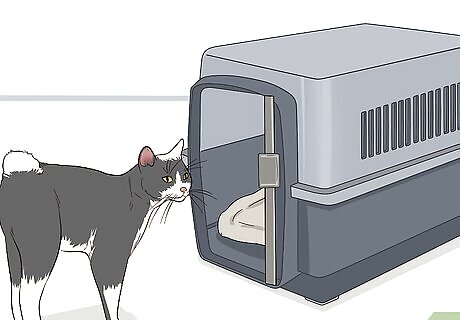
Catch the feral cat. Don’t be surprised if the feral cat bolts if you try to get near her. Setting a humane live animal trap will be the only safe way for you to catch her and bring her into your home. A live animal humane trap is designed such that the door will close behind the feral cat when she steps on a panel at the bottom of the trap. To entice her into the trap, place some tasty morsels of the food at the back of the trap. She may be frightened at the sound of the door closing when she steps on the panel. However, she will not be injured. Live humane traps are available online. Consider contacting your local animal shelter or animal control to inquire about borrowing a trap. Place some comfortable bedding (towels or blankets) in the trap.

Feed the feral cat outdoors. Taming a feral cat should be done inside your home. However, the feral cat’s fear of human interaction presents a problem with bringing her into your home. Feeding the feral cat outdoors can help her at least begin to trust you, or at least trust that you will feed her. Feed her at the same time each day.
Handling a Feral Cat

Spend time with the feral cat without handling her. After the feral cat has had some time to settle in, begin to interact with her to start getting her accustomed to human interaction. To prevent scratches and bites, wear long sleeves, pants, gloves, and shoes when you enter the room. You may also want to have a piece of cardboard that you can hold up in case she lunges at you. Plan to spend time with her at about the same time every day—having a routine will help her settle into your home. Knock before you open the door, and enter slowly. Talk to her quietly as you tend to her needs (e.g., cleaning her litter box, replacing her food and water. Do not stare or make eye contact with the feral cat—she could perceive this as aggression. Instead, avert your eyes and lower your head. As she becomes more comfortable with you, sit with her for about an hour each in the mornings and evenings. Other than talking to her, you can read a book or work quietly on your laptop. Do not try to handle her at the beginning. Let her go at her own pace.Attempts at handling her would likely result in you getting bitten, scratched, and hissed at.

Play with the feral cat. Playing with the feral cat will help her continue to get more comfortable with you before you handle her. Purchase some lightweight cat toys from your local pet store and let her play with those while you are in the room with her. You can also make a homemade ‘kitty tease toy’: attach a small piece of cloth to a string, and attach the string to a small stick. Do not let her play with the tease toy alone. She could swallow the string, which could lead to intestinal obstruction that would require extensive veterinary care.
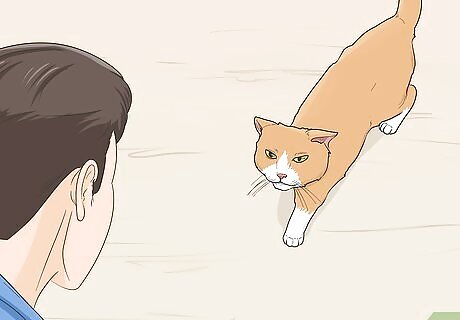
Observe the feral cat’s ‘readiness’ body language. Handling a feral cat can be fraught with danger—she may quickly put up her defenses and attack you out of fear. Observing her body language will let you know if she is comfortable with moving to the next level of human interaction. Body language that indicates she is not ready include making themselves small, hissing at you, and pulling back their ears and whiskers. She may also hiss at you if she does not want you to handle her. If she seems relatively calm when you around her, that is a good clue that she may be ready to be handled.
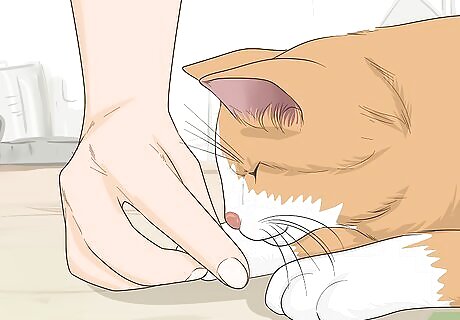
Acclimate the feral cat to your hand. Still wary of more human interaction, the feral cat will need time to adjust to your hand. To begin, place your hand flat on the floor, palm side down. Let her come to you, and allow her to bump into your leg, arm, or hand. Resist the temptation to pet her. Her explorations of you are her way of testing you to see if you are a threat. Keep your hand a small distance away from her at first. As she becomes more comfortable with your hand, move it and your body closer to her. You must allow her to initiate the contact. She may attack if you make the first move.
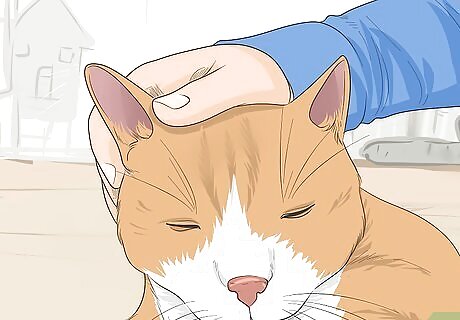
Pet the feral cat. Petting the feral cat may feel like a moment of truth—will she welcome you or attack you? Set a toy near your hand and place your hand flat on the floor. When she approaches, sniffs, and nudges your hand, take this as your cue to slowly lift your hand and hold it at her eye level. Briefly leave your hand at her eye level, then start petting her. Pay attention to her body language—tensed muscles, a swishing tail, dilated pupils, and flattened ears are all signals that you should stop petting her and give her some space. Keep the first petting session brief. It is best to stop petting her before she lets you know she’s had enough.

Pick up the feral cat. If you have a feral kitten, you can try picking her up and setting her in your lap when she becomes more comfortable with you petting her. Keeping in mind that she is still a wild animal, slowly and gently wrap her up with a towel (leaving room to scruff her) to prevent you from getting scratched or bitten. Turn her body such that her head is facing away from you. Scruff her by firmly gripping the skin at the base of her neck. Grasp the skin as close to her ears as possible, making sure not to grasp too tightly. Gently lift the her up in the air and set her gently in your lap. If she will let you, pet her and talk to her in a soothing voice. Although kittens are scruffed by their mothers, do not be surprised if the feral kitten does not like being scruffed by you. Read her body signals to determine if she likes or dislikes being scruffed. Never reach for a feral cat or kitten from its front.

Groom the feral cat. Grooming the feral cat not only gets her more comfortable with human interaction and handling, but also helps you keep her skin and coat healthy. Brush her with a soft-bristled pet brush. You can also comb her with a flea comb to remove fleas. Combs and brushes are available at your local pet store. Flea infestations in feral kittens can be very dangerous, leading to potentially fatal anemia. In addition to combing her with a flea comb, she will need to take a flea preventative (available through your veterinarian).
Determining if You Can Tame a Feral Cat

Assess how feral the cat is. Feral cats are either totally feral (no human contact or only negative human contact), semi-feral (some positive human contact), or converted feral (abandoned house cat that becomes semi-feral). Totally feral cats will be the most difficult to tame and socialize, and converted feral cats will be the easiest. Semi-feral cats look to humans to feed them, but do not seek further human interaction. This minimal level of human interaction teaches them important social cues of the human world. Semi-feral cats are sometimes referred to as ‘community cats.’
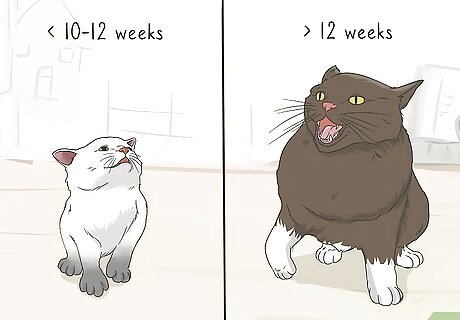
Identify the feral cat’s approximate age. Having a rough estimate of the feral cat’s age can let you know how easy or difficult it may be to tame her. Feral kittens, particularly those younger than 10 to 12 weeks old, are usually easily tamable. Older feral cats who have been feral for a long time will be most difficult to tame, if you can tame them at all. Feral kittens should not be removed from their mothers until they are ready to be weaned, at approximately 6-8 weeks of age. Experts widely agree that for kittens with a domesticated mother, 13 weeks is the appropriate time for separation. For feral mothers, the kittens should ideally be separated from mum at 6-8 weeks - if they stay longer with a feral mum, they will be taught feral behaviors and will take longer to tame. The litter should be kept together for at least a few weeks so the kittens can learn from each other. If you see a feral kitten with his mother, trap the mother and kitten at the same time. Keep them together inside your home until the kitten is ready to be weened, usually about 6-8 weeks. Contact the local animal rescue to have the mother spayed and returned to her colony.
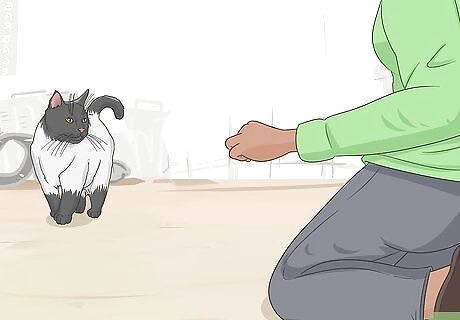
Determine your ability to tame a feral cat. Taming a feral cat is difficult and comes with no guarantee that the taming will be successful. In addition to being a challenge, taming a feral cat can take a lot of time: feral kittens could be tamed in as little as two to six weeks, but it could be a year or more before an adult feral cat is tamed. Acclimating a feral cat to your home and socializing her could require several hours of your time per day, potentially for months on end. Be honest with yourself if you can handle this level of daily commitment. Paying for the feral cat’s veterinary care will likely be expensive. Determine if you are in a financial position to pay for the feral cat’s care.


















Comments
0 comment